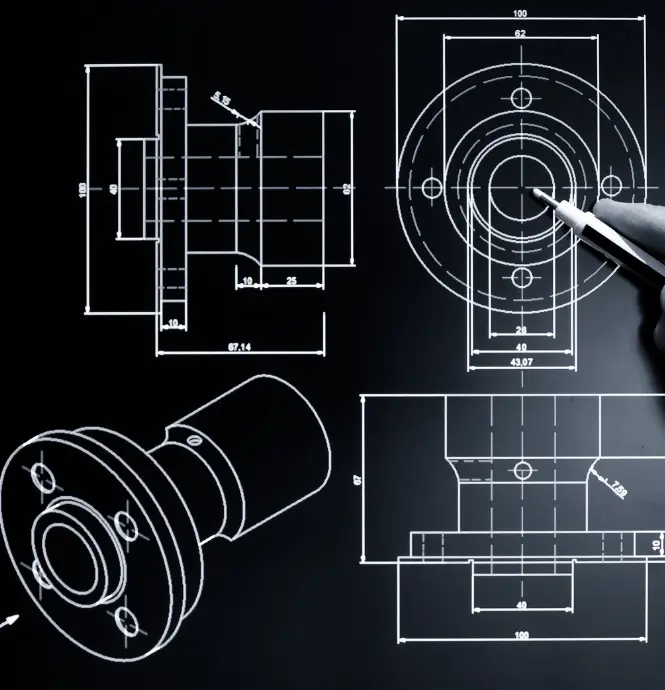Computer-aided design (CAD) rendering is a sophisticated and essential aspect of modern design and engineering.
It bridges the gap between conceptual ideas and actual visuals, enabling designers, architects, and engineers to create detailed and realistic images of their projects before they are built.
CAD rendering involves the use of computer software to create photorealistic images or animations of a design.
This process takes a 2D or 3D CAD model and applies textures, lighting, and shading to produce an image that looks as if it were a photograph of a real object. The purpose is to visualize how a final product will look and function in the real world.
Rendering is the final step in the CAD design process, converting the wireframe models and basic shapes into detailed images. This transformation is critical for identifying potential design issues, showcasing products to clients, and marketing purposes.
Importance Of CAD Rendering
The importance of CAD rendering is listed below:
Visualization and Communication
-
CAD rendering allows designers to communicate their ideas effectively. A photorealistic image is more easily understood by clients and stakeholders compared to technical drawings or sketches.
-
It helps in visualizing complex designs, making it easier to identify potential issues and improvements before actual production begins.
Cost and Time Efficiency
-
By identifying issues early in the design process, CAD rendering saves time and reduces costs associated with modifications and rework during production.
-
It enables virtual prototyping, which is cheaper and faster than creating physical prototypes.
Marketing and Presentation
-
High-quality rendered images are essential for marketing and advertising. They allow companies to showcase products before they are manufactured.
-
Rendered animations can be used in promotional videos, websites, and presentations to attract potential customers and investors.
Enhanced Design Quality
-
Rendering provides a detailed view of the design, allowing for better evaluation and refinement.
-
Designers can experiment with different materials, colors, and lighting conditions to achieve the desired look and feel.
Applications of CAD Rendering
CAD rendering finds applications in various fields, including:
-
Architecture: Architects use CAD rendering to create realistic visualizations of buildings and landscapes. This helps in presenting designs to clients, obtaining approvals, and planning construction. It is also used in urban planning to visualize how new buildings will integrate with existing structures.
-
Automotive Industry: Car manufacturers use CAD rendering to design and showcase new vehicle models. This includes exterior designs, interior layouts, and even virtual test drives. It helps in analyzing aerodynamics and aesthetics before creating physical prototypes.
-
Product Design: Industrial designers use CAD rendering to visualize consumer products such as electronics, furniture, and appliances. This aids in evaluating the design and functionality. Rendered images are used in product catalogs, advertisements, and online stores.
-
Entertainment: In the film and gaming industry, CAD rendering is used to create realistic environments, characters, and special effects. This enhances the visual experience for audiences. It is also used in virtual reality (VR) and augmented reality (AR) applications.
-
Medical Field: Medical professionals use CAD rendering to create detailed models of organs, surgical instruments, and prosthetics. This helps in planning surgeries and training medical students. It is also used in creating educational materials and simulations.
Future Trends Of CAD Rendering
The field of CAD rendering is continuously evolving with advancements in technology. Some future trends include:
-
Real-Time Rendering: With the development of powerful GPUs and rendering engines, real-time rendering is becoming more feasible. This allows designers to see changes instantly, speeding up the design process.
-
Artificial Intelligence: AI is being integrated into rendering software to automate tasks such as texture generation, lighting setup, and scene optimization. This reduces the time and effort required for rendering.
-
Virtual and Augmented Reality: VR and AR are revolutionizing the way designs are presented and experienced. CAD rendering is being used to create immersive virtual environments for better visualization and interaction.
-
Cloud Rendering: Cloud-based rendering services are gaining popularity as they offer scalability and reduce the need for expensive hardware. Designers can render complex scenes quickly using cloud resources.
The Final Thoughts
In short, CAD rendering is an indispensable tool in modern design and engineering. It transforms conceptual designs into realistic images, enabling better visualization, communication, and decision-making.
With continuous technological advancements, CAD rendering is set to become even more powerful and accessible, driving innovation across various industries.
Whether you are an architect, product designer, or engineer, getting CAD rendering can significantly enhance your creative capabilities and professional success.



